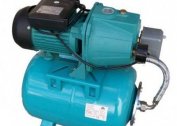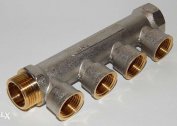According to statistics, 60 percent of breakdowns in water supply systems occur due to water hammer. It leads to a stop of water supply and even to local flooding in the house. But with the proper installation and operation of the highway, you can avoid problems with its operation and appeal to the court of flooded neighbors from below.
The concept of water hammer in a water supply system
A hydroblow is a shock wave propagating along the surface of a pipeline, as well as through reinforcing elements. The destructive effect is obtained due to a sharp difference in pressure in the water supply system and the inability to compress water.
A similar phenomenon occurs accompanied by various noises inside the pipeline, clicks, taps. If you do not attach importance to sounds, it threatens with serious consequences. Water hammer causes cracking and breakthrough of pipes, leading to breakdown of equipment and valves.
How does water hammer occur:
- The fluid flow collides with an obstacle that appears in its path, such as an air plug.
- Due to the high speed, the water layers are compacted, the dynamic pressure increases.
- Water cannot go anywhere because the pipe is airtight. An increase in pressure on the walls of the water supply system entails its damage.
The manifestation of water hammer becomes noticeable at high speeds of the water flow in the pipes, a strong pipeline of large cross-section and a sharp overlap of the passage in any section of the water supply.
Causes
The risk of water hammer is maximum when abruptly opening or closing the overlapping element of the internal water supply network.
Other causes of increased pressure in the pipes:
- An air lock has occurred in the closed loop of the network.
- The circulating pump is floundering or out of order.
- The pump unit turns on and off uncontrollably due to interruptions in the power grid.
- Water enters the mains in excess of normal.
Often the cause of dynamic shock is the use of ball valves in home water supply. Their design does not provide for a smooth run, and the overlap of the water flow occurs very quickly.
Dangerous effects
 With repeated exposure to high pressure, even reliable systems are able to depressurize. A water breakthrough can occur with a single, but strong blow. The water supply to the facilities to which the highway is connected becomes impossible. The results of this phenomenon lead not only to the lack of water in the tap.
With repeated exposure to high pressure, even reliable systems are able to depressurize. A water breakthrough can occur with a single, but strong blow. The water supply to the facilities to which the highway is connected becomes impossible. The results of this phenomenon lead not only to the lack of water in the tap.
In emergency situations as a result of water hammer suffers:
- Equipment - pipes will become leaking, locking devices will be damaged.
- Property - a flood of water will flood the room, which will cause damaged furniture and coatings - not only in your apartment, but also in the neighbors below.
- People - if a breakthrough appears in a heating pipe or hot supply system, there is a risk of thermal burns.
The rupture of the water main, which provides water to the entire urban area, is considered an emergency.
The extent of the damage mostly depends on the area of the obstacle. If it is at the beginning of the water supply, the high pressure indicator will be insignificant, but if at the end it will be much higher.
How to avoid water hammer
Without the conversion of the water circuit, the only protection against water hammer is the smooth overlap of the shut-off element. If the valve closes tightly, it is permissible to move the handle in small jerks.This method can be applied to cranes in the home and in production.
It is possible to partially upgrade a home water supply system by connecting pumping equipment with an automated control unit. Smooth pressure adjustment in the network is achieved by installing devices with automatic change in the number of revolutions or with built-in frequency converters.
Comprehensive protection against water hammer in the apartment’s water supply system is carried out by the following methods:
- Installation of large diameter pipes. This helps reduce the likelihood of water hammer. The speed of water advancement in wide highways is always lower, in contrast to narrow ones.
- Inserting shock-absorbing elastic inserts in front of the overlapping element, expanding with increasing pressure, partially reducing it. To achieve the desired result, shock absorbers with a length of 20-30 cm are quite enough. If the water supply system stretches for a long distance, the size of the insert increases by 10 cm.
- Mounting a diaphragm type safety valve. It is installed on the outlet of the water supply line next to the pump in order to discharge a predetermined volume of liquid with increasing pressure.
Such a shock absorber in internal water supply systems is driven by an electric command of the controller or by means of a pilot rapid response device. The safety element is triggered when the pressure rises above a safe level, protecting the pumping equipment in case of an unexpected stop. At the moment of excessive increase in pressure, the regulator fully opens, and when the pressure decreases to an acceptable value, the valve slowly closes.
The use of hydraulic accumulators as compensators also helps to minimize the effects of a sharp increase in pressure in the water supply system. The design of the installation is a metal casing with a rubber diaphragm located inside. With water hammer, the membrane part is displaced, so that the hydraulic tank takes in excess water. When the threat of a breakthrough of the water supply system passes and the pressure decreases, the diaphragm will return to its original position due to the pressure of the air located on the other side.
A powerful water hammer in a hot water supply or heating network can be avoided by equipping the thermoregulation valve with a shunt - a narrow tube with an internal cross section of 0.2 to 0.4 mm, which is placed in the direction of movement of the coolant.
Shunting is used in the arrangement of independent systems in which only new pipes were used. Rust and sediment in old pipelines will reduce the efficiency of the shunt to zero. Therefore, when the tube is placed at the entrance to the system, it is advised to install effective water filter elements.
Also in networks where boiling water circulates, protective thermostats are installed. They monitor the pressure in the network and do not allow it to function after reaching a dangerous value. The unit is equipped with a spring mechanism, which is located between the thermal head and the valve. The operation of the spring mechanism occurs at elevated pressure, preventing the valve from completely closing. Installation of thermostats is carried out in strict accordance with the direction indicated on the housing.
To avoid water hammer, it is important to regularly check the performance of all nodes and elements of the water supply line, cleaning and flushing the filtration devices. If the pressure drop and damage to the network occurred on a site related to common property, repair work and compensation for damage should be made by the management company.




